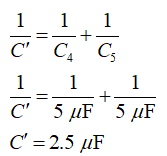College Physics
11th Edition
ISBN:9781305952300
Author:Raymond A. Serway, Chris Vuille
Publisher:Raymond A. Serway, Chris Vuille
Chapter1: Units, Trigonometry. And Vectors
Section: Chapter Questions
Problem 1CQ: Estimate the order of magnitude of the length, in meters, of each of the following; (a) a mouse, (b)...
Related questions
Question
find charges on each capacitor
find voltage on each capacitor

Transcribed Image Text:### Capacitor Circuit Analysis
#### Overview
This instructional module features a capacitor circuit, comprising five capacitors \((C_1, C_2, C_3, C_4, C_5)\) and a voltage source \(V\).
#### Capacitor and Voltage Specifications
Each capacitor in the circuit has a capacitance value of \(5\,\mu F\):
- \(C_1 = 5\,\mu F\)
- \(C_2 = 5\,\mu F\)
- \(C_3 = 5\,\mu F\)
- \(C_4 = 5\,\mu F\)
- \(C_5 = 5\,\mu F\)
The voltage source \(V\) provides a constant voltage of \(10\,V\).
#### Circuit Description
In this circuit:
- \(C_1\) is connected in series with \(C_2\), forming one branch of the circuit.
- \(C_3\) is connected in parallel with the series combination of \(C_1\) and \(C_2\).
- \(C_4\) and \(C_5\) are connected in series to each other, and this combination is connected in parallel with both \(C_3\) and the series combination of \(C_1\) and \(C_2\).
#### Switch Option
There is a feature labeled "Change circuit" that, when activated, implies an ability to modify the circuit configuration, though it is static in the given visual representation.
#### Solution Verification
A checkbox labeled "Solution" is marked, suggesting that the circuit analysis is complete or verified.
#### Conclusion
This example illustrates the interaction between capacitors in series and parallel configurations and how to find the equivalent capacitance or analyze the voltage distribution across the capacitors in such a mixed network.
### Note to Students
Understanding the arrangement of capacitors in such combination circuits is crucial for analyzing electrical systems. Calculating the equivalent capacitance and understanding the voltage and charge distribution across each capacitor will be an essential part of mastering circuit design and analysis.
Expert Solution
Step 1
The capacitors 4 and 5 are connected in series. Calculate the equivalent capacitance of these two capacitors. The charge on these capacitors will be the same, that is, q4=q5.

Step 2
Now, the capacitors 1, 2, 3, and C’ are connected in parallel. Calculate the equivalent capacitance of all these capacitors.

Step 3
Since, the capacitors 1, 2, 3, and C’ are connected in parallel, the voltage across all these capacitors will be the same. Thus,

Step by step
Solved in 6 steps with 6 images

Knowledge Booster
Learn more about
Need a deep-dive on the concept behind this application? Look no further. Learn more about this topic, physics and related others by exploring similar questions and additional content below.Recommended textbooks for you

College Physics
Physics
ISBN:
9781305952300
Author:
Raymond A. Serway, Chris Vuille
Publisher:
Cengage Learning

University Physics (14th Edition)
Physics
ISBN:
9780133969290
Author:
Hugh D. Young, Roger A. Freedman
Publisher:
PEARSON

Introduction To Quantum Mechanics
Physics
ISBN:
9781107189638
Author:
Griffiths, David J., Schroeter, Darrell F.
Publisher:
Cambridge University Press

College Physics
Physics
ISBN:
9781305952300
Author:
Raymond A. Serway, Chris Vuille
Publisher:
Cengage Learning

University Physics (14th Edition)
Physics
ISBN:
9780133969290
Author:
Hugh D. Young, Roger A. Freedman
Publisher:
PEARSON

Introduction To Quantum Mechanics
Physics
ISBN:
9781107189638
Author:
Griffiths, David J., Schroeter, Darrell F.
Publisher:
Cambridge University Press

Physics for Scientists and Engineers
Physics
ISBN:
9781337553278
Author:
Raymond A. Serway, John W. Jewett
Publisher:
Cengage Learning

Lecture- Tutorials for Introductory Astronomy
Physics
ISBN:
9780321820464
Author:
Edward E. Prather, Tim P. Slater, Jeff P. Adams, Gina Brissenden
Publisher:
Addison-Wesley

College Physics: A Strategic Approach (4th Editio…
Physics
ISBN:
9780134609034
Author:
Randall D. Knight (Professor Emeritus), Brian Jones, Stuart Field
Publisher:
PEARSON